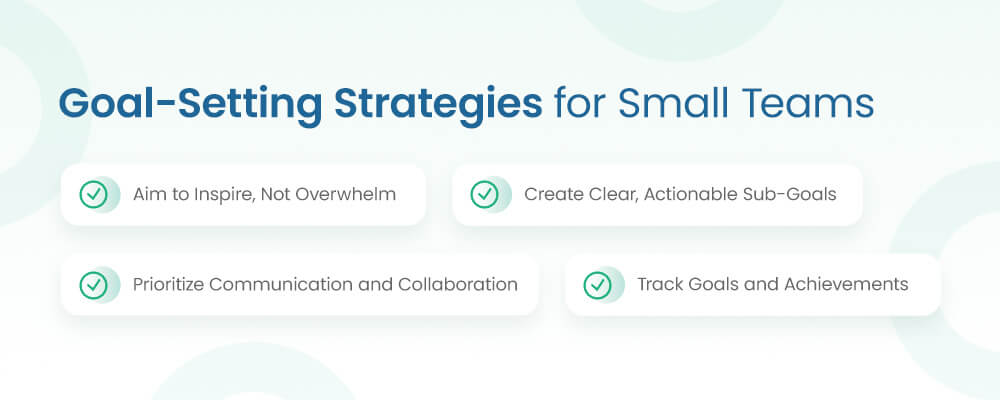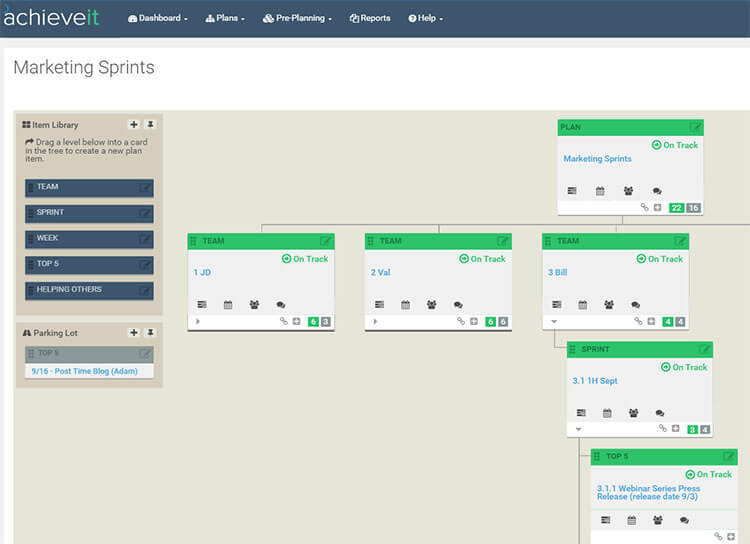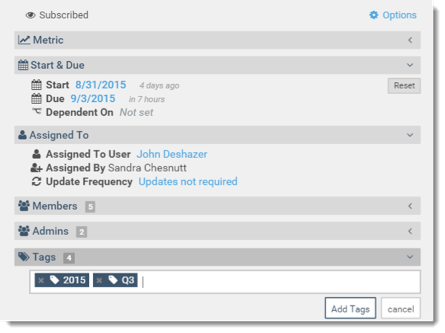Small teams can achieve big things, but unfortunately, it is often harder for them to do so. However, these teams also bring with them a unique strength that larger organizations cannot match. The smaller scale fosters a tight-knit community and work culture rooted in direct communication, agility and a shared mission. With the right objectives and the proper goal management, a limited team can exceed expectations.
Learn how to motivate a small team to achieve goals and accomplish more below.
In This Article
- Why Goal Management Is Nonnegotiable for Small Team Success
- Goal-Setting Strategies for Small Teams
- Goal Tracking in Action
- Overcoming Common Goal Management Hurdles for Small Teams
- Cost-Effective Workplace Tools That Work for Small Teams
Why Goal Management Is Nonnegotiable for Small Team Success
Proper, effective goal management is crucial for small teams and startups. Here’s why:
- Everyone is vital: In small teams, every team member contributes a significant, visible percentage to the team’s overall output. Clear goals ensure everyone’s effort is focused in the same direction.
- Resources are limited: Small teams have fewer resources to work with, and as a result, they have to make those resources count. Specific, achievable goals help your team avoid burnout and redundant work.
- Unity leads to results: Teamwide goals keep everyone on the same page and working toward the same purpose. Small teams may be easier to manage, but that doesn’t make goal setting any less important.
- Context matters: Members often feel more motivated and purposeful when they see that their efforts are directly contributing to the organization’s goals, which can lead to increased output and team cohesion.
- Goals are growth: Setting small, achievable goals can boost team members’ confidence and motivate them to take on bigger challenges.
Together, these effects can radically improve your team’s efficiency, efficacy and confidence. As a result, effective goal setting for startups and other small teams is a must.
Goal-Setting Strategies for Small Teams

Now that you’ve seen some of the benefits of goal management, it’s time to get practical. Here are the steps you can take to empower your team by setting collective goals.
Aim to Inspire, Not Overwhelm
The first step of goal management is setting big goals that all mini objectives are in service of. These goals should be both ambitious and achievable, balancing practicality with competitive spirit.
For smaller teams operating within larger companies, these goals should be specific to your team while aligning with broader company objectives. For startups, they should be wider in scope and focus on performance, profit and local market share.
Your team members should always be included in defining and setting goals so that they feel invested in pursuing shared objectives. This is true whether you’re a startup or part of a larger enterprise. After all, achieving ambitious goals with a small team starts with the team itself.
Annual goals and quarterly goals help your team keep track of progress and stay motivated over time, while broad, ongoing mission statements with no set deadline give your team members and those outside of the organization a clear, concrete sense of how you plan to make change in the world around you in the long term.
Create Clear, Actionable Sub-Goals

Once you and your team have established long-term goals, it’s time to break them down into smaller tasks your team can achieve over shorter periods. These sub-goals should all contribute to your larger goals and bring your team closer to achieving them on a daily basis and beyond.
You can decide on what these sub-goals should be by adhering to frameworks like SMART, which stands for:
- Specific: Use exacting precision when setting a goal. It should be detailed and particular in its focus and scope.
- Measurable: Ensure your team’s work can be evaluated by setting goals that are measured numerically. Whether you’re looking to improve the star rating of the average customer review or increase team member efficiency, work toward a concrete number so your team knows whether they have succeeded or not.
- Achievable: Set goals that are feasible based on past performance and current means. It’s okay to set ambitious goals, even in the short term, but they should always be within reach.
- Relevant: Set goals that are connected to your team’s work directly. If the goal is arbitrary or connected to factors beyond the team’s control, they may get frustrated or feel unmotivated.
- Time-bound: Ensure your goal has a deadline attached. Deadlines foster urgency and motivation while also providing a context for measuring progress. Without a deadline, you cannot gain a proper sense of your team’s performance.
Imbuing small team project management goals with these attributes means that your whole organization will find success when your team does. As your team achieves these smaller SMART goals, the big goals become easier and easier to accomplish.
When dealing with smaller goals, your team needs to know who is responsible for what. Make assignments clear, especially when team members have overlapping roles, as this prevents redundant work and optimizes your team’s efficiency.
When deciding which sub-goals to prioritize, consider which ones will have the greatest impact on the big goals your team is pursuing. Identifying impact like this can be difficult, so rely on your team members to provide insight into which goals they’re responsible for are most impactful. You can then provide a broader perspective on how these sub-goals serve the larger goals.
Prioritize Communication and Collaboration
At the heart of both setting and achieving goals is communicating with your team. Many companies are content with communicating through emails and evaluations, but these communication methods are often impersonal and do little to foster morale and unity when used in isolation. They have to be supported by other lines of communication, such as regular, informal check-ins and in-person strategy meetings that can directly address goals and foster an environment of open collaboration.
Goal tracking is one of the best communication strategies for small team goals. You can use shared online documents, project management software or even just a whiteboard in a common space to track and check off goals when they are completed. Tools like these can help your team visualize their work and see the progress they’ve made, both of which can encourage team members and improve morale.
You may find that once strong lines of communication are in place and team members feel free to give feedback and support one another, the work environment radically improves. Keeping small teams aligned on objectives and giving them the power to shape those objectives together can make a huge difference.
Track Goals and Achievements
The last two pieces of the goal management puzzle are feedback and adaptation. Both are supported by a culture of communication, but they require additional intention and teamwide mechanisms in order to become a reality.

First, establish a system of progress reviews. Many small teams like to host weekly or bi-weekly huddles where they can go over updates and progress that was made in the previous week. With small teams, these meetings provide a chance for team members to build community and unite around common goals while also providing feedback and adjusting strategy as necessary. Going over key performance indicators (KPIs) is a great way to keep the team up to date.
These meetings can also provide an excellent opportunity to go over feedback with the team, whether it’s provided during the meeting or via an anonymous submission box or an online document shared with everyone. Small teams can be far more agile than larger organizations, so it’s important to leverage that agility by hearing members out and being willing to change course.
These meetings can also be a space for celebration. As your team progresses and accomplishes goals and sub-goals, take the time to acknowledge the success and celebrate the team and the work they’ve done. This kind of recognition can improve workplace culture and team member satisfaction and increase the team’s overall momentum.
Goal Tracking in Action
Now that we’ve gone over the basic steps of the goal-setting process, let’s take a look at how they can be applied within the context of goal management software. In this example, we will be using AchieveIt, our in-house software.
Our company, like yours, has long-term goals it is pursuing. For us, these fall into three categories — annual goals, quarterly goals and quarterly initiatives. Those goals are then broken down into sprints that each team member is responsible for. When they start their sprint, they identify five small goals they want to meet, each of which needs to align with one or more of our big goals.
Within AchieveIt, these sprints are organized within a branching chart and can be found under each person’s name.

That sprint is broken down into the specific sub-tasks that each employee is responsible for within the sprint’s time frame. We then connect these sub-tasks to our big goals by using tags. For instance, we often start by using tags to identify the task’s time frame, which allows us to connect it to the relevant quarterly goals.

For example, two of our quarterly goals are abbreviated as the tags “Inbound” and “Conversion.” We can add these tags to all of the relevant sub-tasks in AchieveIt by using the bulk edit feature.



Now all of our sub-tasks are directly aligned with relevant quarterly goals, making it easy to understand the purpose of each task and stay motivated to complete them.
Overcoming Common Goal Management Hurdles for Small Teams

Managing team goals with limited resources can be a real challenge. Team members often have to stretch to take on new responsibilities, and building trust and communication within any group can be difficult, no matter the group’s size. Here’s how you can make sure your team stays united and agile:
- Work with what you have: If your team is struggling with limited resources, whether related to time, budgets or staff, look for opportunities to do more with less. Ruthlessly prioritize the most impactful goals for your team, work with free or low-cost tools wherever possible and encourage skill-sharing among team members. These strategies can make performance goals for small business teams achievable, even if you’re working with fewer resources.
- Accommodate your team’s needs: If team members need to wear multiple hats simultaneously, goals must remain attainable within the confines of the time they spend carrying out each role they play on the team. When team members are stretched like this, it is doubly important for them to feel encouraged and supported. Be quick to congratulate progress and ensure lines of communication are open so that they can offer feedback and take care of their duties and those of the team.
- Remain clear: If distractions are an issue within the team, there may be an issue with the goals that have been set. Ensure that they adhere to SMART principles and have been communicated clearly so that each team member can invest in them and the team’s progress as a whole.
- Keep goals realistic: If burnout is an issue, your goals may be too ambitious. Your team won’t be able to reach goals if they are stretched too thin, so focus on listening to team members and adjusting workloads across the team to be more sustainable.
- Communicate openly: If your team is consistently failing to communicate and meet goals, it may be that the trust and responsibility your team needs to thrive are not there. Micromanagement is not the solution here. Instead, focus on building open lines of communication and investment in the team’s collective goals. Team members need to be able to buy into those goals and feel that they are achievable in order to make progress together.
Cost-Effective Workplace Tools That Work for Small Teams
Many smaller teams benefit from using cost-effective workplace tools — both digital and otherwise — to track and manage their goals.
Trello and Asana are great digital options for organizing your team’s tasks and goals. Asana offers deep insights into your team’s long-term progress and allows you to work with multiple projects simultaneously. Trello is friendlier to small teams due to its more straightforward interface. Both offer versions of their software that are free, and their basic tiers come at a lower price point than many alternatives do. Google Workspace tools such as Sheets and Tasks can also support the goal setting of smaller teams.
Community whiteboards are a more humble option that can serve multiple purposes. They can track goals, and they can also be a site where team members build camaraderie by celebrating one another and building a shared culture. They are also easy to access, set up and use, making them a great option for any workplace. Their public nature may not be perfect for every team, but the fact that anyone can view them can increase trust and openness within yours.
AchieveIt: Your Team’s Goal Management Solution
If you’re searching for a goal management software that can radically boost your team’s productivity, search no more. AchieveIt is the software for you, and it can empower your small team to achieve its biggest goals. Our software helps you lay out plans big and small, increase your team’s productivity and assess overall performance across time. Our interface is intuitive and even offers automated update collection, report compilation and more, so your team can focus on what really matters.
To learn more about how AchieveIt can unleash your team’s full potential, request a demo today.



